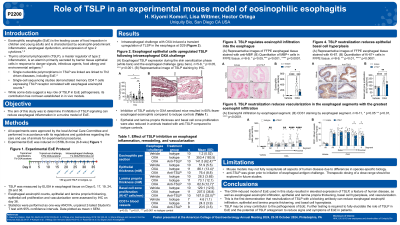Monday Poster Session
Category: Esophagus
P2200 - Role of TSLP in an Experimental Mouse Model of Eosinophilic Esophagitis
Monday, October 28, 2024
10:30 AM - 4:00 PM ET
Location: Exhibit Hall E

Has Audio
- KK
Kiyomi Komori, PhD
Uniquity Bio
San Diego, CA
Presenting Author(s)
Kiyomi Komori, PhD1, Lisa Wittmer, PhD2, Hector Ortega, MD3
1Uniquity Bio, San Diego, CA; 2Uniquity BIo, Malvern, PA; 3Uniquity BIo, San Diego, CA
Introduction: Eosinophilic esophagitis (EoE) is the leading cause of food impaction in children and young adults. EoE is characterized by eosinophil-predominant inflammation, esophageal dysfunction, and expression of Th2 cytokines. Thymic stromal lymphopoietin (TSLP), a master regulator of Th2 inflammation, is a cytokine primarily secreted by barrier tissue epithelial cells in response to danger signals, infectious agents, food allergy and environmental antigens. Genetic studies link single nucleotide polymorphisms in TSLP to Th2 driven diseases, including EoE. Recent single-cell sequencing studies demonstrated memory CD4 T cells expressing TSLP receptor correlated with esophageal eosinophil counts. While some data suggest a key role of TSLP in EoE pathogenesis, its contribution has not been established in in vivo models.
Methods: Experimental EoE was induced in wild type mice by skin-sensitization using oxazolone (OXA,17 D) followed by intraesophageal challenge with OXA or vehicle control (19 D, total duration 36 D). Esophageal TSLP was measured during the sensitization and challenge periods. To determine the role of TSLP in EoE, treatment with a TSLP neutralizing antibody or isotype control began prior to esophageal challenge. Esophageal eosinophil counts, epithelial and lamina propria thickening, epithelial cell proliferation and vascularization were assessed on D36.
Results: Intraesophageal challenge with OXA induced a transient upregulation of TSLP in the esophagus at D29, with TSLP expressed primarily in esophageal epithelial cells. Inhibition of TSLP activity in OXA sensitized mice resulted in 60% fewer eosinophils compared to isotype treated controls (p< 0.001). TSLP neutralization also statistically significantly reduced epithelial and lamina propria thickness and basal cell zone proliferation (Table 1). When assessed by region, anti-TSLP treatment statistically significantly reduced esophageal vascularization in regions with the highest degree of eosinophil infiltration.
Discussion: TSLP neutralization in an experimental EoE mouse model demonstrated a key role of TSLP in EoE pathogenesis. Inhibition of TSLP markedly decreased esophageal eosinophilia, a key diagnostic criterion for EoE. Other histologic features of EoE were also reduced upon TSLP neutralization. Together with genetic and mechanistic studies associating TSLP with EoE pathogenesis, this data suggests TSLP may serve as a treatment target for patients with EoE.
Note: The table for this abstract can be viewed in the ePoster Gallery section of the ACG 2024 ePoster Site or in The American Journal of Gastroenterology's abstract supplement issue, both of which will be available starting October 27, 2024.
Disclosures:
Kiyomi Komori, PhD1, Lisa Wittmer, PhD2, Hector Ortega, MD3. P2200 - Role of TSLP in an Experimental Mouse Model of Eosinophilic Esophagitis, ACG 2024 Annual Scientific Meeting Abstracts. Philadelphia, PA: American College of Gastroenterology.
1Uniquity Bio, San Diego, CA; 2Uniquity BIo, Malvern, PA; 3Uniquity BIo, San Diego, CA
Introduction: Eosinophilic esophagitis (EoE) is the leading cause of food impaction in children and young adults. EoE is characterized by eosinophil-predominant inflammation, esophageal dysfunction, and expression of Th2 cytokines. Thymic stromal lymphopoietin (TSLP), a master regulator of Th2 inflammation, is a cytokine primarily secreted by barrier tissue epithelial cells in response to danger signals, infectious agents, food allergy and environmental antigens. Genetic studies link single nucleotide polymorphisms in TSLP to Th2 driven diseases, including EoE. Recent single-cell sequencing studies demonstrated memory CD4 T cells expressing TSLP receptor correlated with esophageal eosinophil counts. While some data suggest a key role of TSLP in EoE pathogenesis, its contribution has not been established in in vivo models.
Methods: Experimental EoE was induced in wild type mice by skin-sensitization using oxazolone (OXA,17 D) followed by intraesophageal challenge with OXA or vehicle control (19 D, total duration 36 D). Esophageal TSLP was measured during the sensitization and challenge periods. To determine the role of TSLP in EoE, treatment with a TSLP neutralizing antibody or isotype control began prior to esophageal challenge. Esophageal eosinophil counts, epithelial and lamina propria thickening, epithelial cell proliferation and vascularization were assessed on D36.
Results: Intraesophageal challenge with OXA induced a transient upregulation of TSLP in the esophagus at D29, with TSLP expressed primarily in esophageal epithelial cells. Inhibition of TSLP activity in OXA sensitized mice resulted in 60% fewer eosinophils compared to isotype treated controls (p< 0.001). TSLP neutralization also statistically significantly reduced epithelial and lamina propria thickness and basal cell zone proliferation (Table 1). When assessed by region, anti-TSLP treatment statistically significantly reduced esophageal vascularization in regions with the highest degree of eosinophil infiltration.
Discussion: TSLP neutralization in an experimental EoE mouse model demonstrated a key role of TSLP in EoE pathogenesis. Inhibition of TSLP markedly decreased esophageal eosinophilia, a key diagnostic criterion for EoE. Other histologic features of EoE were also reduced upon TSLP neutralization. Together with genetic and mechanistic studies associating TSLP with EoE pathogenesis, this data suggests TSLP may serve as a treatment target for patients with EoE.
Note: The table for this abstract can be viewed in the ePoster Gallery section of the ACG 2024 ePoster Site or in The American Journal of Gastroenterology's abstract supplement issue, both of which will be available starting October 27, 2024.
Disclosures:
Kiyomi Komori: Kinevant Sciences – Consultant, Employee. Uniquity Bio – Employee.
Lisa Wittmer: Uniquity Bio – Employee.
Hector Ortega: Uniquity Bio – Employee.
Kiyomi Komori, PhD1, Lisa Wittmer, PhD2, Hector Ortega, MD3. P2200 - Role of TSLP in an Experimental Mouse Model of Eosinophilic Esophagitis, ACG 2024 Annual Scientific Meeting Abstracts. Philadelphia, PA: American College of Gastroenterology.

